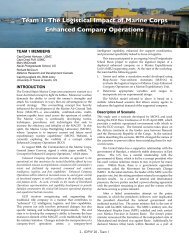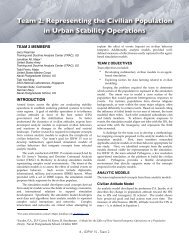pdf file - SEED Center for Data Farming - Naval Postgraduate School
pdf file - SEED Center for Data Farming - Naval Postgraduate School
pdf file - SEED Center for Data Farming - Naval Postgraduate School
You also want an ePaper? Increase the reach of your titles
YUMPU automatically turns print PDFs into web optimized ePapers that Google loves.
stepwise regression results. The significant input factors are<br />
presented in Figure 3.<br />
points. Stepwise regression was executed and JMP® selected<br />
the coefficients and that played a significant role in predicting<br />
the OSD. To prevent over fitting only the top 10 significant<br />
terms were taken from the Stepwise regression and used in<br />
the Least Squares regression. Limiting Least Squares to only<br />
the top 10 coefficients eliminated the problem of over fitting<br />
the data but still resulted in the R2 and adjusted R2 being<br />
above the .90 level.<br />
Figure 3: JMP® Output of Significant Factors from Plackett-<br />
Burman Experiments<br />
Figure 5: Cross validation plot<br />
Figure 4: Follow-on Experiment Results<br />
In order to ensure that these terms are in fact significant,<br />
follow-on experiments were conducted. The follow-on<br />
experiment consisted of changing only the top nine factors<br />
from the previous experiment and holding the other 42<br />
coefficients at their default values. A space filling experiment<br />
was used in order to provide more degrees of freedom to test<br />
<strong>for</strong> significance of higher order polynomial terms and to<br />
provide any de-aliasing necessary <strong>for</strong> the terms identified as<br />
significant. Once complete the results of the 20 runs were<br />
processed and compared to the default coefficient OSD listed<br />
as experiment 21 on Figure 4.<br />
Manipulation of the nine coefficients in the follow-on<br />
experimental design resulted in 75% of the OSDs being below<br />
the current default OSD. These results are encouraging and<br />
show that these nine coefficients are important and can be<br />
used to reduce the overall OSD in future experiments.<br />
All of the experiments completed were cross validated to<br />
see which coefficients (linear, squared, or interaction) were<br />
robust with respect to predictive abilities. The data points<br />
were placed into JMP® except <strong>for</strong> 10 randomly excluded<br />
CONCLUSIONS<br />
The DOX principles guided the execution of experiments<br />
on the ES model and ensured a comprehensive exploration of<br />
the problem space and efficient use of computer processing<br />
resources. The DOX provided valuable insight into how the<br />
coefficient inputs affect the OSD. The initial screening<br />
experiments also highlighted what areas require additional<br />
experiments.<br />
Based off the work conducted at the IDFW, Team 5 was<br />
able to illustrate that the ES model outcome can be predicted<br />
by using a small subset of the significant coefficients. The<br />
cross validation of the current work shows that the coefficients<br />
still require more experimentation in order to produce a good<br />
working model <strong>for</strong> predicting the OSD. Based off the work<br />
conducted here additional experiments will be executed and a<br />
working mathematical model will be <strong>for</strong>mulated.<br />
REMARKS<br />
The research into the ES model is ongoing and is<br />
expected to be completed by the end of June. The hope<br />
continues to be that this research will gain new insights into<br />
the ES model and help the United States Army personnel<br />
optimization.<br />
REFERENCES<br />
[1] http://www.armyG1.army.mil/<br />
[2] Hall, Andrew O. Validation of the Enlisted Grade Model<br />
Gradebreaks. Winter Simulations Conference, 2004:<br />
921-925<br />
[3] Montgomery, Douglas C. Design and Analysis of<br />
Experiments 7th Edition. New York: John Wiley & Sons,<br />
2009.<br />
19 - IDFW 20 - Team 5




